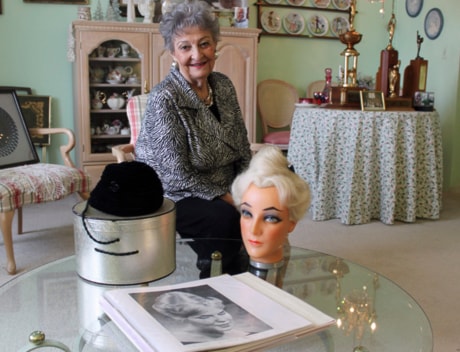ELMHURST, Ill. — Before Marge Simpson, Amy Winehouse or Audrey Hepburn wore their hair in the famous beehive, there was Margaret Vinci Heldt and her salon on Chicago’s ritzy Michigan Avenue.
As the 92-year-old retired hairstylist tells it, Modern Beauty Shop magazine (now Modern Salon) was looking for a new design, something different to feature in its February 1960 issue. She came up with the beehive.
“I went home and I thought, ‘What am I going to do that hasn’t done before?”’ Heldt said.
Inspiration came to her in a little black velvet hat, shaped like a small bump and lined on the inside with red lace. Heldt went downstairs to her family room one night while her family was sleeping. She put on a little music and started working with hair atop a mannequin head.
“Before you know it something was coming out,” she said. “And I thought, ‘I like this.”’
It became what the magazine called “the beehive.” Now more than a half-century later, Heldt is garnering accolades and attention. Today the hat sits atop a gold metallic hat box on Heldt’s living room coffee table. The box reads Lorraine’s Footlight Hat Shop.
This March the trade group Cosmetologists Chicago will give its first scholarship in Heldt’s name for creativity in hairdressing, and the Chicago History Museum is taking steps to include that velvet hat and mannequin into its collection.
The beehive became a cultural phenomenon during the 1960s and evolved into a style worn today as Hollywood’s starlets walk red carpets.
“If it’s done right it’s so classic,” said Jay Manuel, creative director and judge on America’s Next Top Model and host of the Style Her Famous makeover series. “It’s this punctuation point. It makes a statement, but at the same time it doesn’t take away from you.”
With her bubbly and energetic personality, Heldt shows all the enthusiasm for hairstyling today that you would imagine at the height of her career a half-century ago. Trophies for her hairstyling work fill a table in her small apartment, and she has a glass case of beautiful hair combs.
She’s animated when she talks about how the beehive’s popularity grew quickly — and got out of control.
“Oh, what atrociousness, it grew into bigger and bigger, higher and higher,” she said. “It didn’t just stay a beehive. It lasted a long time and it keeps coming back.”
The hairstyle was attractive to shorter women who were looking for height, Heldt said.
“The showgirls, they loved it because it made them willowy and tall,” she said.
Ann Bray, a hairstylist who owns The Masters Salon in Huntsville, Ala., remembers waiting for hours outside Heldt’s classrooms at trade shows to learn her techniques. “At that time I was a young hairdresser and we were all doing the beehive,” Bray said. “Ladies would come in with short hair and they would have an itty-bitty ant hill. They would bring in hair pieces because they wanted a beehive.”
The magazine’s article describes the style as “smooth and sweeping as to line, provocative as to detail” and “tall wrap-around crown, creating a circular silhouette with high-rise accents.”
Heldt grew up on Chicago’s West Side and loved hair as a little girl. When she was seven or eight years old a friend took her to a hair salon and she says she was fascinated.
“After that I didn’t want to play with dolls anymore,” she said. “I wanted to play beauty salon.”
In high school she won a beauty school scholarship, but her family couldn’t afford to buy her a hair switch — a piece of fabric with long hair attached so students could practise. She cut her mother’s long hair into a short bob and sewed the hair onto burlap to use in class. She passed the state board exam in 1935. Heldt opened her own salon — Margaret Vinci Coiffures — on Michigan Avenue in 1950.
“It was a very glamorous place,” said Timothy Long, costume curator at the Chicago History Museum. It was open “certainly at a time when a woman venturing into certain businesses wasn’t as common as it was today.”
The salon moved to the suburbs in the 1970s and was sold in the 1980s. Heldt retired in the 1990s.
Now superlatives reign from her colleagues and admirers: The Ultimate. Our Grand Dame. Queen of the Beehive Hairdo. She won the National Coiffure Championship in 1954.
“Without any reservations I say that she certainly is an icon in the industry,” said Mario Tricoci, a hairstylist who owns 18 Mario Tricoci Hair Salon and Day Spa locations in two states. He has know Heldt for decades.
